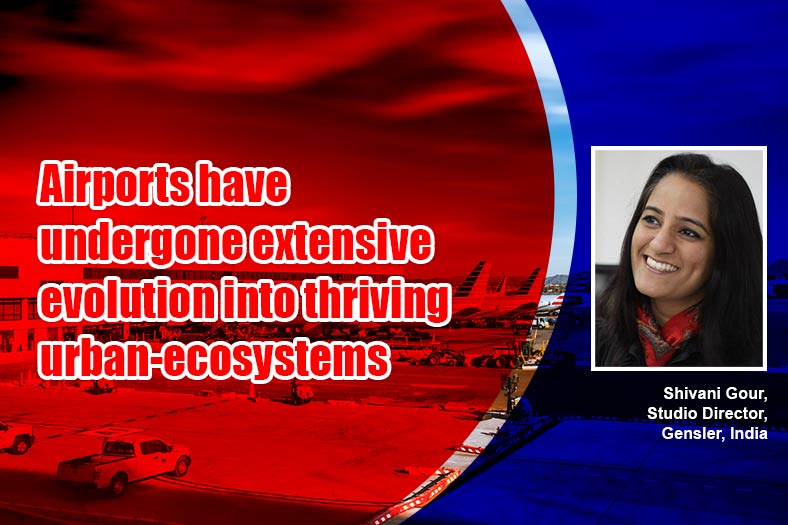An accelerated implementation of touchless technologies has begun at airports

An airport’s local context is, therefore, its ground of germination, so it may potentially anchor its future development. From this perspective it becomes vital for it to be rooted in its cultural context to suitably serve its people says Shivani Gour, Studio Director, Gensler, India.

What are some of the major changes in airport design one will be witnessing in the post Covid-19 era?
The biggest challenge for today’s airports is to regain consumer confidence and ensure staff safety. While the focus stays on health and hygiene, what actually helps build the confidence back is the consistency with which the new practices are implemented. And hence a less-temporal/ more long-term investment is needed to develop infrastructure & systems to ensure confidence building, both with airport staff and passengers.
An accelerated implementation of touch-less technologies is already underway in major airports. To name a few, contact-less service kiosks, curb-side baggage self-check ins, cashless transactions, contactless boarding entry turnstiles etc. are some of the newly added features which are fast becoming a norm.
For airport employees, centralized entry points for screening and delivering, plus purpose-built amenities dedicated to staff wellness, will become essential components of terminal planning.
Moreover, there is heightened attention towards air-quality social distancing. To cater to this need, physiologically and psychologically, curating opportunities for fresh air-intake would increase and introduction of nature’s elements in the overall journeys would be well received. Demand for semi-enclosed spaces for individual needs will also increase.
In the current times, health screening and monitoring have overtaken all other functions, resulting in added travel stress and increased travel-time. In such a scenario it has become even more crucial to ease travel related stress.
Hence on one hand there would be attempt to make the access through the terminal easy and seamless through prompt signage and clear way-finding, on the other hand new typologies of spaces will emerge that would allow for releasing stress and offering memorable experiences. More than ever, the need will arise to reclaim pleasurable moments in a journey, making way for innovative and fresh thinking that re-imagines airports beyond travel gateways!
Especially for large airports what kind of facilities are needed to ensure navigating within the airport is easier? Going contactless from curb to gate, calls for a thorough assessment of all touch points in the journey; and when the airports are large, every step adds to the complexity.
Clear signage and wayfinding are an immediate area of action, required on all operational airports. But for the upcoming airports however, the passenger flow needs to be planned to allow for intuitive movement through the terminal, reducing the reliance on signage. Beyond flow management, special measures need to be taken for elimination of queues and crowds at all access points as well as dwelling-zones.
Latest development in Indoor Positioning Systems can drastically alter the way a passenger navigates through a terminal. It can be further linked with other service offerings of the terminal to make a passenger’s experience more meaningful and efficient. For example, in the post-security passenger-amenities, contact-less pick-ups and alternative delivery options for in-line retail and F&B outlets can be linked with this navigation system. This can help release dense occupancy pockets and in return offer convenience to the end-user.
Furthermore, other technology solutions like Integration of UV screening can help ease off congestion points. Remote health screening and app-based services for faster drop-off/ pick-up, can make the entry/ exit experience swifter and more stress-free. At customs and security screening, existing bio-metric procedures can be boosted with added provisions for mass screenings. For easing out arrivals flow, provisions must be made to guide guests about local guidelines and procedures, overall calling for an enhanced customer service engagement, either in-person or through AI tools.
The pandemic has also brought forth the differences in the needs of varied user-groups – for e.g. an elderly person’s concerns and challenges have become even more dissimilar from a younger traveler. To make the travel-experience pleasant for all, Terminal Design will have to evolve to offer more customized services; in the process, redefining the new ‘premium travel’ experience.

In India as also in some other parts of the world, major airports are limited to metros alone. Do you see any kind of decentralization happening there in the near future?
The post-covid times have compelled all sectors to turn to more sustainable models and decentralization is just one of the facets of this approach. Not just airports but entire urban development has catapulted towards regionalization. This has given a major thrust to the development of small-scale airports across the country.
While demands on the metropolitan airports will continue to grow, domestic air-traffic-needs continue to rise even in the pandemic times. To make the small-scale airports successful, sustainable practices need to be adopted as a business model. Considering our recent contribution and innovation in the alternative
energy sector, India in particular, can be a front runner in showing the way to faster, better and cheaper airport design.
What kind of multi-modal integration is necessary to ensure that access to the airport becomes easier?
The pandemic has propelled us into the future sooner than we could imagine. With immediate addressal of current needs, now is also the time to consider long-term strategies and solutions to prepare and plan for cities that offer hassle free and time-saving traveler experience; multi-modal connections to an airport are essential to achieve this. Depending on its city’s infrastructure, an airport can draw traction through various modes of transport, like metro lines, app-based cab services, ride-sharing, public buses, and even chopper-services for fast access through dense city-traffic. Thus, pressure falls again on airport-planning to allow for integration of all such services.
How can airport design serve as a reflection of the region’s culture and aspirations? Can you cite some examples?
Airports have undergone extensive evolution – from being mere gateways to nodal points of development, and eventually turning into thriving urban-ecosystems. An airport’s local context is, therefore, its ground of germination, so it may potentially anchor its future development. From this perspective it becomes vital for it to be rooted in its cultural context to suitably serve its people.
Gensler is currently working on designing Lounges and hotel spaces in Bangalore International Airport’s Terminal 2. Being part of the ‘Garden City’ the overall experience of these spaces is created as part of Nature’s canvas. It takes its inspiration from the six unique seasons of India, the blooming flowers of Bengaluru, and the city’s Lalbagh conservatory. Also representing the tech-capital and its tech savvy-traveler, this project uses technology to deliver a world-class traveler-experience that embraces the local eco-system through a contemporary expression of its regional crafts. The facility is designed to offer choice to its users, with wellness in the fore front and a flavor that is unique to its place.
Cookie Consent
We use cookies to personalize your experience. By continuing to visit this website you agree to our Terms & Conditions, Privacy Policy and Cookie Policy.









